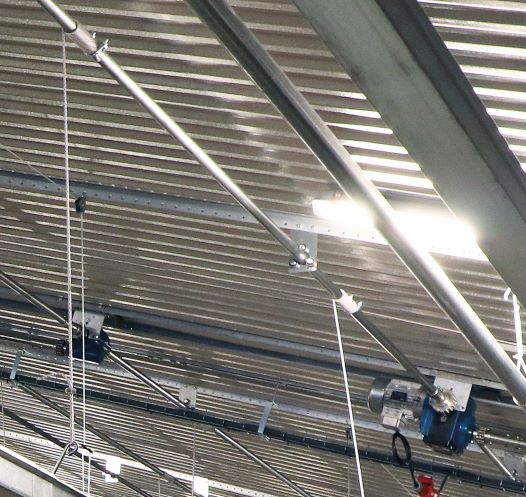The design of poultry houses has changed very little over the years, but there are now more options for feeding and drinking equipment than ever before
In just over 30 years, Dalton Engineering has become one of the UK’s main agricultural suppliers and installers. It was one of the first UK companies to supply and install suspended feeding and drinking equipment and is now UK agent for VDL Agrotech, Vostermans and Microfan. Very little has changed in this period from an installation perspective, according to the company. Wooden posted houses, for example are still built with trusses at 10ft centres.
Keeping it level
All Dalton troughs and drinkers are made in 10ft (3.048m) lengths: this keeps systems level, as the suspension points are always directly under a truss. With a European three metre trough, the 48mm loss at each suspension point soon results in the trough ending up mid bay, making it difficult to keep level. Exposed wooden trusses also offer great installation flexibility. It’s no problem moving equipment 50mm laterally, as there is the whole truss available.
While steel-framed houses have their advantages greater planning and design time is required with the house builders. Positions of the feeders and drinkers must be accurately specified in order to hit the 200mm x 50mm undersection timber at installation.
Repositioning at installation requires removal of roof sheets to install noggins at 10ft centres or making steel brackets to span across the purlins. Raising and lowering of feeding equipment has traditionally been done by electric or manual winch. The main ‘pulling’ cable is usually 5mm galvanised wire, with a 3mm drop wire at each suspension point. The drop wire is then located over a pulley and tagged onto the main cable. The winch is anchored to the building and draws the main cable around a winch drum or tube, lifting the equipment. The ‘centre loop’ of cable should be checked daily by farm staff for signs of wear and tear. This cable does all the lifting work and Dalton recommends changing the centre loops after every 1,500 daily cycles.
To winch or not to winch?
Some breeder houses have the feed systems designed to be winched every day. There are two main purposes to this. The first is so feed can be distributed whilst raised, then lowered to ensure all birds get fed simultaneously. This stops birds chasing the feed around the house. Secondly, when daily feeding has finished the system is wound back up, leaving the floor area clear for mating activities.
Alternatively, breeders sometimes now opt to keep feeders at working height during the flock, only winching up at turnaround. This has improved safety implications and feed is distributed faster using inverter controlled
fast drives. This can result in feeders running with a chain speed of 39m per minute, with two hoppers per circuit, halving the feed time. The height of the trough allows for the birds to pass underneath.
A superior and safer alternative to both these options is the VDL tube winching system. This allows the clear floor space of the traditional daily winching, but is far safer. A tube is positioned the full length of the house; this is rotated by the winch instead of a main pulling cable. Only the individual drop wires, generally a re-enforced typtoline cord, are wrapped on to the tube. The advantage is that if one drop wire snaps, then the rest of the system should stay suspended. If the traditional main pulling cable snaps, at least half the feeder line will drop to the floor.
Weight loading
When considering suspended chain feeder installation, weight loading of the house is vitally important. In a breeder house with trough, excluder grill, feed and feed chain, the combined equipment weight can soon reach five or six tonnes. Pullet rearing requires multiple feed circuits to achieve the required feed space. With the added weight of birds on suspended tables, raised perching and above the feeders and drinkers, weight loading can be colossal. If half of the birds in a 16,000 bird-rearing house perch on roof-suspended equipment, the increase in load could be around 10 tonnes, plus up to 3 to 4 tonnes of the other
equipment.
Whist it is accepted that this weight is distributed reasonably evenly, it still very important to consider all weight loading. Some older cage houses, re-purposed for other types of birds, generally weren’t built to have suspended feeding systems, and as such have little structurally integrity and limited insulation.


